Advertising industry: India
Contents |
Advertising campaigns of note
An overview, till 2022
August 14, 2022: The Times of India
There are many mirrors in which we can see our evolution in the 75 years that have gone by since Independence, and advertising is a particularly interesting one. For it tells us stories about how we wish to see ourselves, and with time it becomes a text in which we can see how we have evolved as a society.
In the early years, advertising played a minor role in our lives. It was a time when both consumption and media access were limited. There were still quite a few iconic campaigns, many using mascots as an easy way to gain memorability – the Murphy baby, the subject of much myth, the Zodiac man, and the Air India Maharaja whose witticisms, sometimes bordering on the risque, opened a new chapter in advertising, which another remarkable long-running campaign, Amul, has taken forward with even more memorability and longevity.
The 1960s and 70s were a time when the country eased up a little – popular cinema became more colourful and escapist, and advertising took on an element of fantasy. Consumption was limited to a small class and the popular campaigns tended to present even ordinary acts of consumption as exotic and glamorous. Liril relocated the bath from small bathrooms to a waterfall and history was made. Four Square cigarettes exhorted us to Live Life Kingsize. Nescafe showed a bunch of impossibly beautiful people riding a buggy while sipping coffee.
The ’80s and the first whiff of liberalisation is the time when the idea of the middle class got crystallised. Advertising helped create a more tangible idea of the consuming class, organising diverse constituencies under a common label. Several campaigns constructed the idea of a shared value system and helped give the middle class a coherent selfimage to hold on to. Perhaps the most memorable campaign of this kind was Hamara Bajaj, which struck a resonant note as it showed us vignettes of ourselves with unerring accuracy. VIP suitcases with its ‘Kal Bhi, Aaj Bhi’ subtly navigated between a nostalgic past and a modernising future. The ‘Mile Sur Mera Tumhara’ campaign, while not selling any product, was another marker of this era, as it wrapped us all in a sense of shared goodwill.
As the first burst of local entrepreneurial energy hit the country, we saw many iconic campaigns that spoke with a new directness and urgency. Nirma burst on to the scene with a simplicity and force that sliced through our collective consciousness. Nothing captured the unvarnished hunger of an emerging class impatient to make a mark as did this brand with its unsophisticated but highly effective entry.
Rasna, with its ‘I love You, Rasna’ campaign featuring an adorable moppet was another brand that offered the middle class access to an experience that was otherwise not available to it. Vimal’s advertising was a counterpoint to the studied ‘gentlemanliness’ of other brands in the space featuring the Vimal Man who used more overt materialistic markers to broadcast his success.
The mid-90s saw the full force of Liberalisation hit us. There was a sense of optimism that advertising helped articulate. The Pepsi campaigns beginning with its launch, ‘Yeh Dil Maange More’ and ‘Nothing Official About It’ all in their own ways captured the unshackling of the spirit. The Cadbury’s Dairy Milk ad with its uninhibited female protagonist seemed to vividly echo a sentiment a large section of society felt.
The ’90s and early 2000s were the heyday of advertising. Television came into its own, and with it came a brand of storytelling as rooted as it was entertaining. There were many iconic ads of this time. Fevicol produced a series of memorable campaigns, each funnier than the last. Coca- Cola brought alive a new kind of protagonist, full of bravado and local wisdom in its ‘Thanda Matlab Coca-Cola’ series featuring Aamir Khan in different avatars. Happydent was perhaps the pinnacle of entertainment with its larger-than-life storytelling.
As the idea of consumption matured, we began to see a string of campaigns that strove to do more than just entertain. Brands began to take on the mantle of shaping society, if not through their actions then at least in advertising depictions. Tata Tea with its ‘Jaago Re’ campaign was an early mover, exhorting us to take a more active role in society. Ariel’s ‘Share the Load’ campaign attempted to correct the imbalance in the household ties between the genders. Tanishq’s remarriage ad sensitively broke a social taboo by depicting a woman with a child getting married again.
Through the years, advertising has been a fascinating document of the changes women have gone through. From a time when ads showed women as mother and wife playing the role of the nurturer, or drew largely on their appearance – the classic Lux campaign that over the years featured glamorous film stars being a case in point – several iconic campaigns have striven to create new archetypes that reflect and even nudge forward changes in society.
Notable campaigns include Surf’s Lalitaji featuring a woman who drew respect for mind rather than her appearance, the Cadbury’s Dairy Milk ad showed a woman comfortably expressing herself uninhibitedly in public, the Ericsson phones ad that represented a steely executive cutting a self-important man down to size, Airtel’s recent campaign that showed a woman as her husband’s boss at work, Ariel’s ‘Share the Load’ campaign that pushed for a more equitable sharing of household responsibilities – these have all played their role in changing the narrative around gender.
With the arrival of the internet, advertising has lost some of its universality. As we retreat into our own little affairs with the small screens that govern all aspects of our life, advertising is no longer the shared text it once was. But for the first 75 years after Independence, it was the soundtrack to the little moments of our everyday life and it has a fascinating story to tell.
The 1960s
Asmita Bakshi , Those were the days “India Today” 21/8/2017
Wills
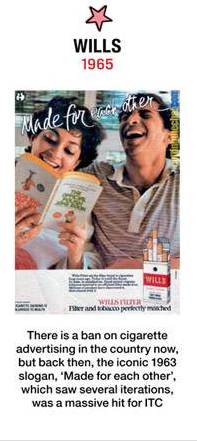
See graphic
Wills
Lifebuoy
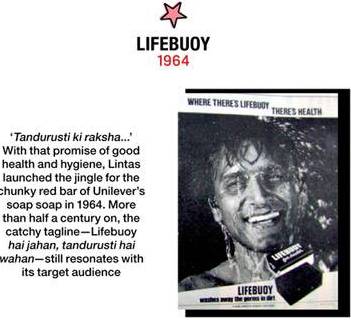
See graphic
Lifebuoy
Ambassador
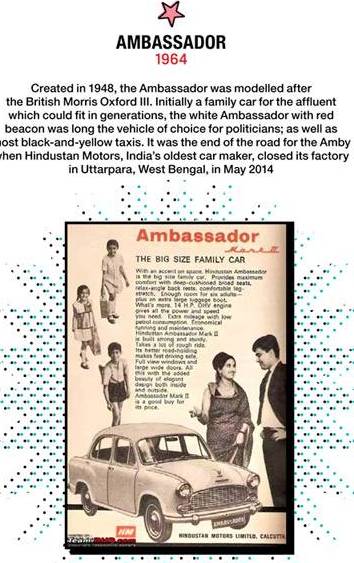
See graphic
Ambassador
Hawkins Pressure Cooker

See graphic
Hawkins Pressure Cooker
Murphy Radio

See graphic
Murphy Radio
Amul Butter
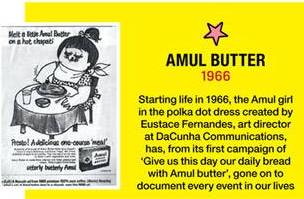
See graphic
Amul Butter
The 1970s
Asmita Bakshi , Those were the days “India Today” 21/8/2017
Campa Cola
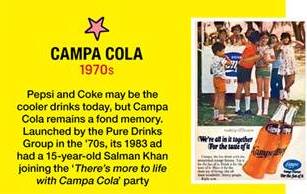
See graphic
Campa Cola
Red and White
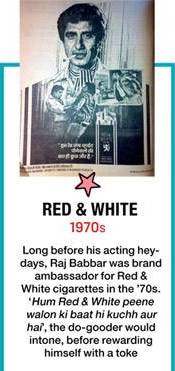
See graphic
Red and White
DCM Towels
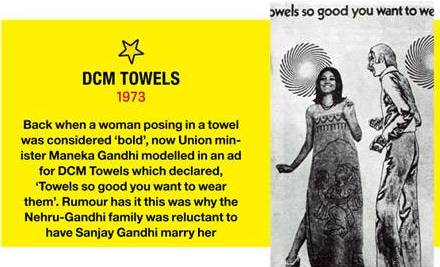
See graphic
DCM Towels
Vimal Suitings
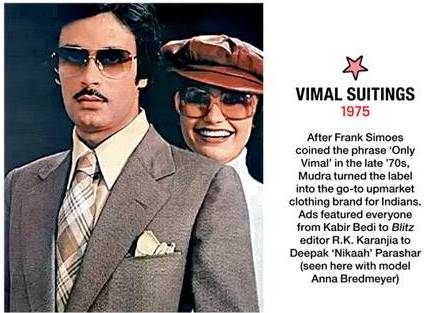
See graphic
Vimal Suitings
Lambretta
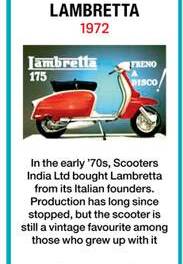
See graphic
Lambretta
Kinetic Luna
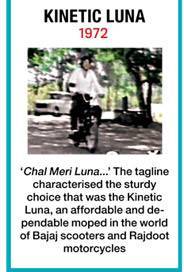
See graphic
Kinetic Luna
Glucose-D
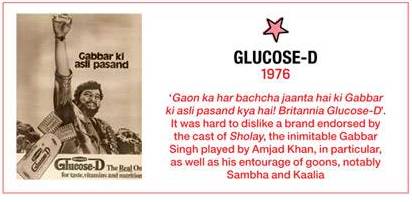
See graphic
Glucose-D
Poppins
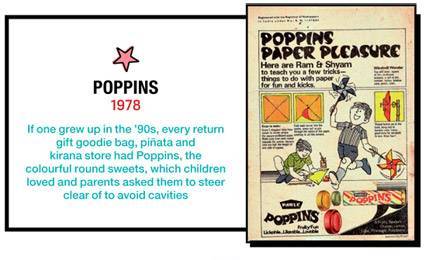
See graphic
Poppins
Promise Toothpaste

See graphic
Promise Toothpaste
Gold Spot
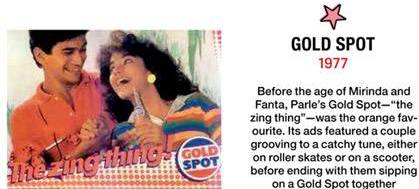
See graphic
Gold Spot
The 1980s
Asmita Bakshi , Tjose were the days “India Today” 21/8/2017
HMT
See graphic

Prestige
See graphic

Cherry Blossom Shoe Polish
See graphic
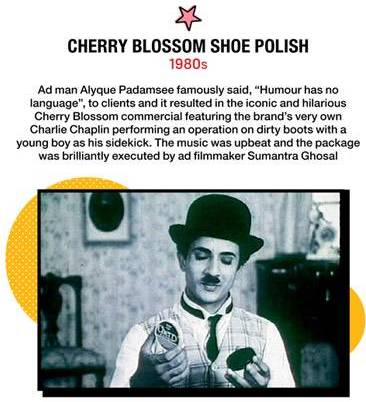
Maggi
See graphic
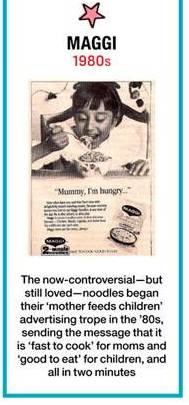
Nirma
See graphic
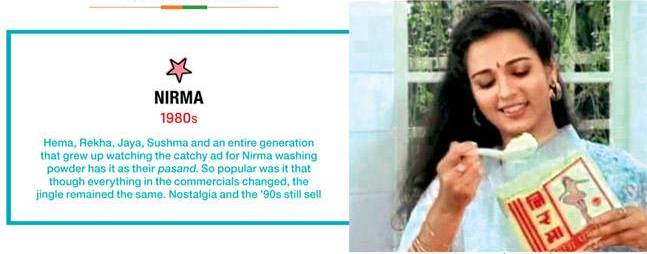
Lijjat Papad
See graphic

Pan Parag
See graphic
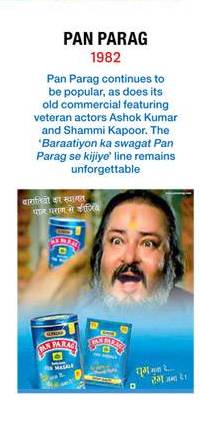
Vicco Turmeric
See graphic

Uncle Chipps
See graphic
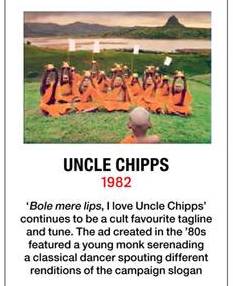
Palmolive Shaving Cream
See graphic
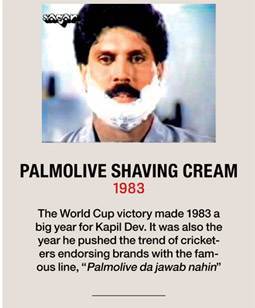
Balaji Bulbs
See graphic
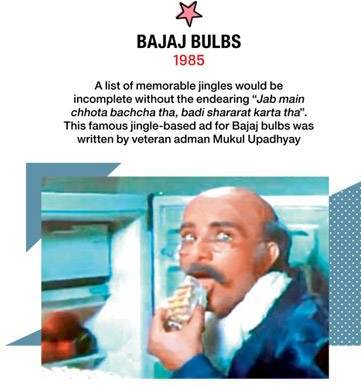
Surf
See graphic
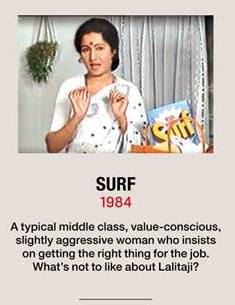
Rasna
See graphic

Liril
See graphic
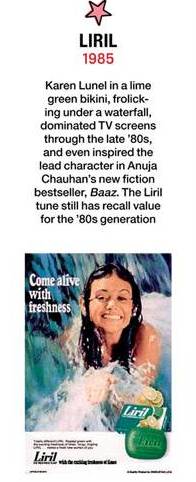
Chelpark Ink
See graphic

Onida TV
See graphic
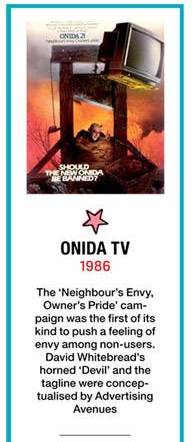
Bajaj Scooters
See graphic
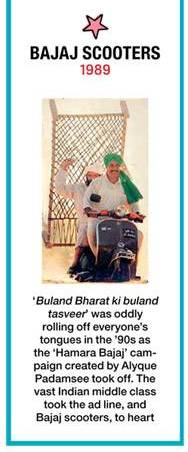
Titan Watches
See graphic

The 1990s
Rashi Walia
Most of us have spent best times of our life in the 90s. TV shows of 90s were beyond doubt an essential part of our lives. Sundays then meant waiting for our favorite shows the whole week and sitting in front of the television with all enthusiasm. These shows left a deep impression in our hearts leaving a lot of memories. Doordarshan was the ultimate source of entertainment during that time and color televisions had just begun to make their way in our households. More than we enjoyed watching 'Mowgli', 'Mahabharath' and the other television shows as a ritual, we thoroughly enjoyed the advertisements that came as fillers.
A trip down the memory lane of TV commercials:

Action School Time Shoes:
Class work, homework, punishment, lecture...This commercial took us to our school days. No one can forget the cute curly haired boy.
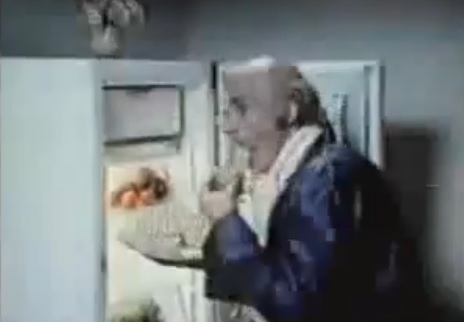
Bajaj Bulbs:
Remember the jingle "Jab main chhota baccha tha, bahut shararat karta tha..meri chori pakdi jaati...kyunki roshan karta bajaj Ab main bilkul Buddha hoon, goli khaake jeeta hun, phir bhi chori pakdi jaati..kyunki roshan karta bajaj". Who doesn't remember the old man recalling his childhood days through Bajaj bulbs! This advertisement takes us to a nostalgic trip. The jingle was catchy and evocative.

Cadbury's:
Cadbury's jingle and the girl's victory dance make us go through the good old days. The jingle 'Kuch baat hai hum sabhi mein' was a huge success making the commercial an iconic one. The girl runs in the cricket field and dances her heart out. The song and the music made this one a hit.
Citra
See graphic
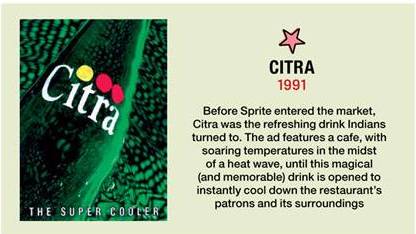
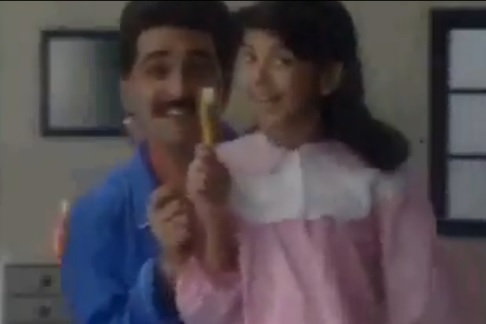
Classic Toothbrush:
Almost every kid of 90s wanted a classic toothbrush after watching this advertisement. You may not remember anything else but 'Lal kala pila..gulabi hara neela' by heart. The father daughter dancing and the colorful brushes was a favorite amongst the little ones.
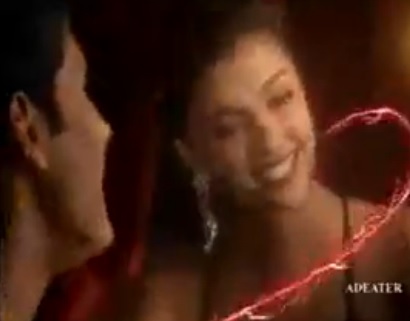
Colgate Gel Ad:
We remember this ad by the cameo done by Aishwarya Rai. Seeing Aishwarya come down from a 60 mm screen to the small screen was a big big deal then. The jingle 'Saanson mein zinda dil taazgi' was sung by the now very popular KK.
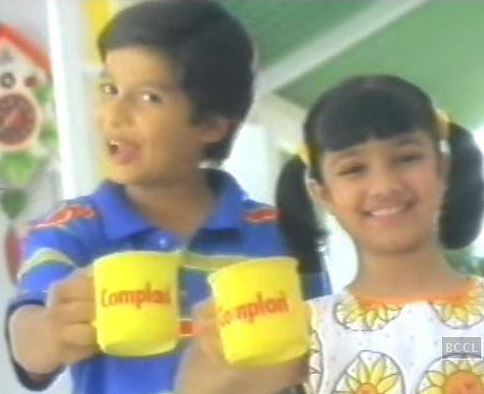
Complan:
I remember saying 'I'm a Complan Girl' if someone asked me about my growing height. Who knew the Complan boy and girl in the commercial would turn out to be Bollywood superstars. Shahid Kapoor and Ayesha Takia were the children in the commercial making it a favorite amongst the growing kids. 'I'm a Complan Boy. I'm a Complan Girl' became an anthem for the children.

Dhara - Jalebi:
This has to be the most adorable advertisement on television. Parzan Dastur is still remembered as the Dhara Jalebi kid. The music in the commercial 'Dhara Dhara Shudh Dhara' made it a huge success. The cute little boy leaves his house because nobody loves him and goes back home after knowing that his mother has made jalebis for him. Dhara was one of the most loved cooking oil brands in India. This ad still brings out the 'awwwwhs' by being simple, sweet and yet effective.
Fevi Kwik
See graphic
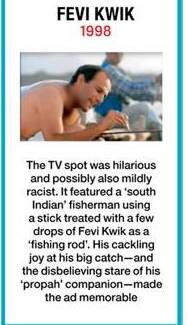
Godrej Prima Typewriters
See graphic
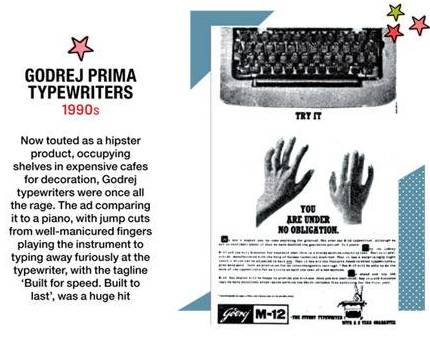
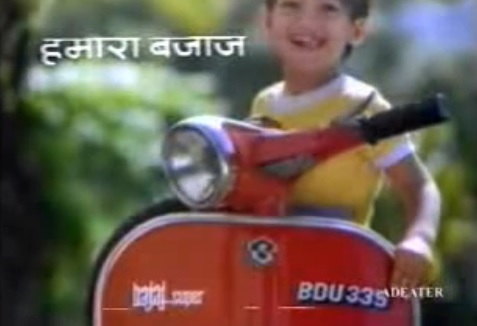
Humara Bajaj:
Almost all of our fathers had a bajaj scooter back in the 90s. This commercial became so popular that Bajaj became the biggest automobile company in India. 'Buland Bharat ki buland tasveer: Humara Bajaj' made the whole nation patriotic. The commercial's music was splendid and beautiful and most of us are still not over it. Humara Bajaj made a storm in the 90s.
Jaipan Mixer Grinder
See graphic
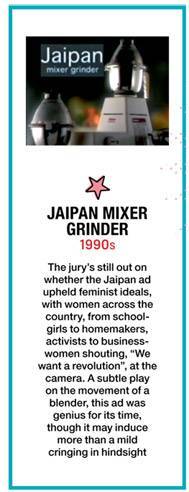
Kissan Jam
See graphic
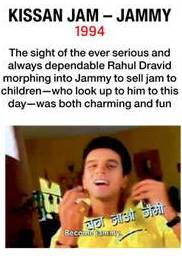
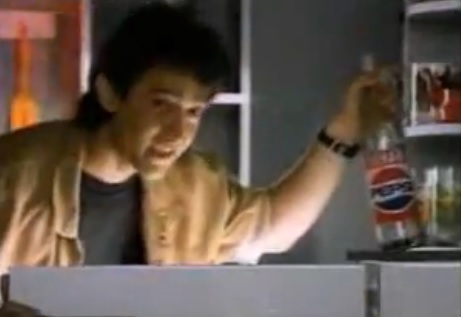
Lehar Pepsi:
It was a huge deal to see Bollywood stars in a TV commercial. This ad launched Aishwarya Rai as Sanjana and it created a storm. It was a starry ad with Amir Khan, Mahima Choudhry and Aishwarya Rai in it. Aish's three second cameo in this commercial made it an overnight success. The commercial was a path breaker for Pepsi.'Yahi Hai Right Choice Baby' was on everyone's lips. The tagline became popular making people buy Pepsi as it was the 'right choice'.
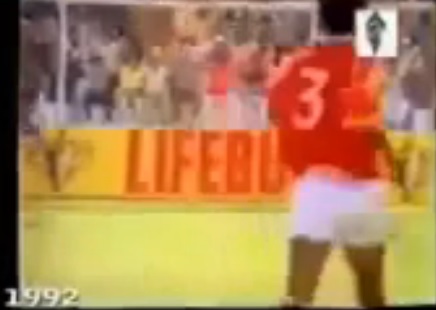
Lifebuoy:
Who isn't familiar with the tagline 'tandurusti ki raksha karta hai Lifebuoy? If you were into sports, you had to bathe with lifebuoy. This classic commercial changed the brand's face making it the most famous bathing soap. The brand got synonymic with health as Lifebuoy hai jahan, tandurusti hai wahan ! The commercial still makes us hum the jingle whenever on air.

Lijjat Paapad:
If you are a 90s kid, you surely remember the famous bunny singing 'ho ho ho lijjat paapad'. The 'karram kurrram' paapad ad featured Ramdas Padhye's Rabbit puppet. The laughter of the bunny turned out to be the USP of the commercial. The commercial had a rustic middle class touch to it and made the yummy crispy paapads world famous.

Liril:
Who can forget the super cute and bubbly Preity Zinta as the Liri girl in this commercial? Dancing under the waterfall with the lime and lemony soap, this ad was one of the iconic TV commercials. The jingle 'La la la la....' still brings a smile on our face on listening to it. Riding the soap bubble, Preity stole this show and brought freshness to the advertisement. It was also one of the earliest colored ads on Indian television.

Mother Dairy:
Doodh, doodh, doodh ; doodh hai wonderful, Pee sakte hai roz glass full; doodh, doodh, doodh..... I remember humming this jingle the whole day. This advertisement was the most fun one of that time. Everybody remembered the whole song by heart. The advertisement did what together was every mom's mission - make us drink milk. The commercial pointed at the advantages of drinking milk by not sounding boring like a teacher. This commercial brought a different tangent to our lives making children love milk. The music, the video and the characters in the ad made it lively and energetic.
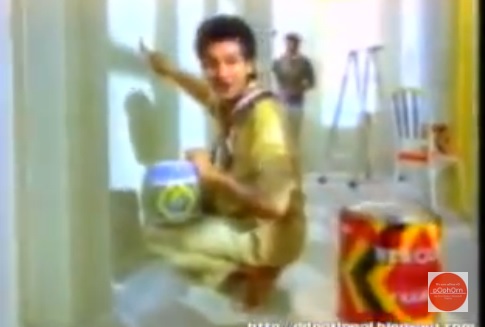
Nerolac Paints:
We cannot forget the jingle 'Jab Ghar Ki Raunak badhani ho, deewaron ko jab sajana ho, Nerolac'. They paint walls while singing this catchy jingles and making music from paint brushes and paint boxes. This advertisement is unforgettable.
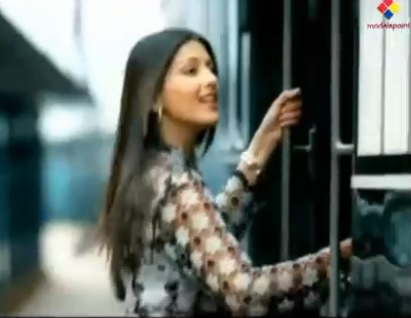
Nirma: Soap
The memorable tune 'Tum husn pari tum jaane jahan' featured a stunning Sonali Bendre brought the young model and brand Nirma to stellary heights. Sonali was seen enjoying around in exotic locations. You surely remembered the jingle by heart as a kid

Nirma: Washing Powder
Ever since the first ad, Nirma, Hema, Rekha, Jaya and Pushpa have surely changed but the jingle has been a constant. 'Hema, Rekha, Jaya aur Pushpa..sabki pasand Nirma' is known by almost everyone of us. The music and the lyrics go so synced that Nirma's commercial became an anthem making washing clothes look like an easy chore out of a fairy tale!
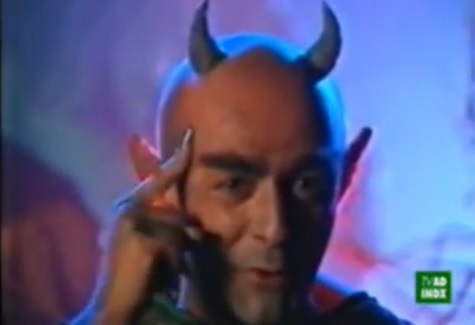
Onida:
The Onida devil sold millions of TV sets! A bald guy with devil horns on his head introduced a lot of features of Onida TV making it the coolest ad of that time. The Onida devil was a favourite in every household.

Pan Parag:
How many of you remember the Baaration ka swaagat Pan Parag se hona chahiye? This classic commercial had the legendary actors Shammi Kapoor and Ashok Kumar together and this was the only time these two actors have worked together. This advertisement still has a high recall value due to the star cast and ofcourse due to the social message of no dowry through it. It is still known as one of the best pieces of advertisements.
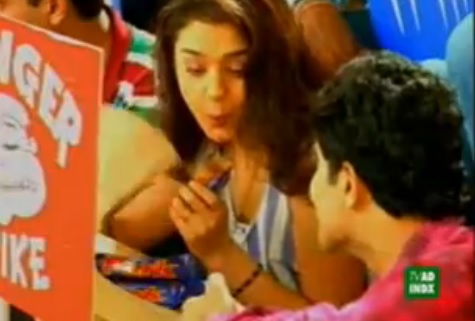
Perk:
Preity Zinta was at her cutest in this commercial. Her career started from this advertisement. The cute bubbly college girl Preity Zinta sitting in a hunger strike ate Perk flashing her dimples. The jingle 'Apna le khushi har pal ki' was a soothing one making Preity Zinta a diva of bollywood overnight.
Polo
See graphic
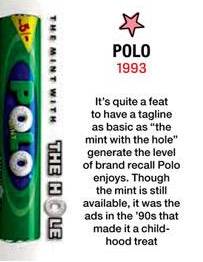

Rasna:
Rasna's TV commercial featured the cute little girl Ankita Zaveri with the tagline 'I love you Rasna'. This is one of the famous 90s commercial showing how simple life was when we were kids. The ad depicts how the little girl gets happiness on her birthday after being served a chilled glass of Orange Rasna.
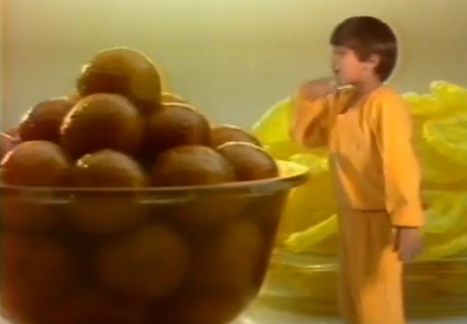
Sundrop Cooking Oil:
We all remember the little boy in his yellow jumpsuit running around giant puris, gulab jamuns and dosa, summer salting his way through food while his mother chased him. The commercial grew on us due to its cuteness quotient and made our taste bud tingle. The tagline 'Healthy Oil for healthy people' made the cooking oil commercial a huge success.

Titan:
Titan melted everyone's heart by showing the bond between a father and a daughter on her wedding. A fragment from Mozart's Symphony 25 has gone on to define India's most iconic watch brand. The TV commercial was exceptionally phenomenal and touched the emotional chord of its viewers.
VIP Frenchie
See graphic
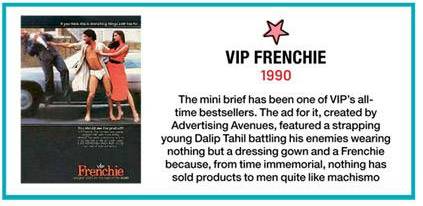

Whirlpool Quick Chill Refrigerator
See graphic
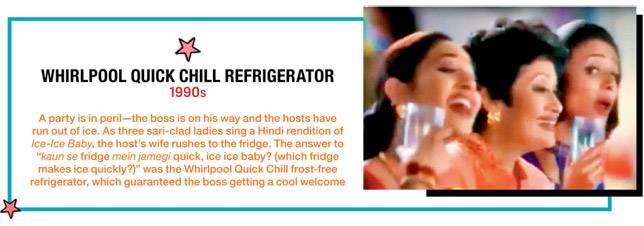
Zandu Balm:
Zandu Balm, Zandu Balm, Peeda haari balm, sardi sar dard peeda ko pal mein door kare Zandu balm...We still hum this song while applying Zandu Balm. This old nostalgic ad was again known for its catchy song and the mother-daughter relationship! And in case you are not from the 90s, check out the commercial to know about Malaika Khan's 'Munni Badnam' inspiration.
The legal position
Private properties and advertisements
Debashish Karmakar, October 22, 2020: The Times of India
The Patna high court paved the way for political parties to put up hoardings, banners, posters and other publicity material on private properties, after seeking written permission from owners, by interpreting private properties as “persons” under the Bihar Prevention of Defacement of Property Act, 1987.
The judgment would allow political parties to put up any number of hoardings, banners and posters as there is no cap on expenditure during an election while candidates have a ceiling of Rs 28 lakh for campaigning as per rules and regulations of the Election Commission (EC).
The judgment was delivered by the bench of Justice Ashutosh Kumar while hearing a writ petition filed by the company Century Business Private Limited, which had been given the contract by BJP for putting up 950 hoardings on private properties across the state for its top functionaries for election campaigning.
However, the office of the chief electoral officer had not granted permission based on Bihar Prevention of Defacement of Property Act, 1987. Sub-section 3 of Section 3 of the Act allows any person contesting an election either as an Independent or on the symbol of a recognised political party to use a private property with the owner’s written consent for election campaign during the period notified by EC for the completion of the electoral process.
Appearing for the firm, senior counsel S D Sanjay, who is also the Centre’s former additional solicitor general, submitted that the CEO has misinterpreted the local law to the extent that it considers only a person or persons and not political parties, which are an association of persons.
The HC’s judgment interpreted private properties as ‘persons’ under the Bihar Prevention of Defacement of Property Act, 1987
Television advertising and celebrities
2013: Filmistan actresses outstrip actors
MUMBAI: Bollywood's leading ladies have pipped their male counterparts on the visibility score on the telly as more brands lapped them up for advertising campaigns in 2012. Female actors saw their presence increase from 40% to 46% in the overall celebrity endorsement market on TV even as male actors stagnated over the last two years with a 38% share, reveals latest data collated by TAM, a television audience measurement agency, and exclusively shared with TOI.
Not surprisingly, sports celebrities saw their visibility decline by 8% from 2011, largely due to the lacklustre performance of the Indian cricket team. Cricketers form the biggest chunk of sports endorsements in India.
Among companies, FMCG biggies Hindustan Unilever (HUL) and Procter & Gamble (P&G) emerged as the two biggest advertisers using celebrities followed by Brooke Bond Lipton and L'Oreal India. Notably, top ten advertisers using celebrities comprised only FMCG brands.
TAM AdEx takes into account advertising volumes for its analysis and tracks the visibility of the celebrities on television. The data is not representative of ad spends or how much the celebrities earn per endorsement.
Shahrukh Khan remained the most visible face on television with an 8% share followed by Kareena Kapoor. Other women actors among top 10 celebrities according to ad volumes were Katrina Kaif, Priyanka Chopra, Kajol and Anushka Sharma.
"FMCG brands have to differentiate themselves in highly penetrated categories like soaps and shampoos. The more undifferentiated your product is, marketers need to bring in a clutter breaking tool and celebrities are a big part of the plan in that case," said Basabdutta Chowdhury, CEO of Platinum Media, a division of media buying group Madison that buys media for FMCG majors like P&G, Marico and Godrej. FMCG brands contribute almost 55% to the overall advertising spends in the country.
Celebrity management firms said with a new brigade of female actors in the endorsement market, more brands are willing to get on board these young faces to tap into the youth factor. Neeraj Garg, VP, juice business, Coca-Cola India, said after signing on Parineeti Chopra for Maaza, "She is a young achiever who epitomizes the young India as someone who is go-getter, energetic, wanting to make a difference and sure of themselves."
Others like Deepika Padukone, Anushka Sharma and Nargis Fakhri have also made an impact on the endorsement scene, mostly in the consumer goods space. However, new faces among the male actors such as Ayushman Khurana and Ranveer Singh have not found the same success.
"For younger female actors there are many categories in the beauty and consumer goods space which are suitable for them to endorse unlike how it is for the male actors," said Anirban Das Blah, chief executive & MD, CAA Kwan, a celebrity management agency.
Celebrity endorsements and the law
2016: Ministerial panel recommends penalty of up to Rs 10 lakh
Dipak Dash, Celebs may face ban for misleading ads. Nov 11 2016 : The Times of India
No Jail Term, Fine Could Go Up To Rs 10L
A panel of ministers has approved imposing a fine of up to Rs 10 lakh and a one year ban on celebrities who endorse products making unrealistic claims for the first offence, but has dropped the controversial proposal for a jail term.
The jail term for celebrities to endorse a product making misleading claims had been recommended by a parliamentary standing committee. The ministerial panel has recommended a penalty of up to Rs 10 lakh fine for the manufacturer and two years jail for first offence, said sources. But even publishers and broadcasters would have to pay up to Rs 10 lakh for every such offence -a recommendation that may prove to be contentious and could, if accepted, be challenged by the publishing industry. For celebrities, the penalty recommended is also up to Rs 50 lakh besides a ban on endorsements for the second and subsequent offences.
For firms which put out misleading advertisements, the panel has suggested a fine of up to Rs 50 lakh and a jail term of five years. There are, however, certain conditions that offer publishers or broadcasters relief if they carry advertisement “in ordinary course of their business“. But they would face action for publishing or broadcasting an ad, if the central authority has notified it as misleading and has ordered its withdrawal.
The “due diligence“ clause for celebrities to avoid penalty would be defined later. These recommendations are likely to be included in the Consumer Protection Bill as well.
ASCI’s 2017 guidelines
New ad norms for celebs, April 14, 2017: The Times of India
Advertising Standards Council of India (ASCI), the ad industry's self-regulatory body, has released a set of guidelines for celebrity endorsements that bring personalities, including doctors, authors, activists and educationists, into the celebrity category . This comes at a time when the Consumer Affairs Ministry is intending to review the Consumer Protection Act and may have a provision to deal with misleading ads.
Apart from actors and sportspersons, well-known personalities are expected to have knowledge of ASCI codes and it is the duty of the advertiser and the agency to make sure that the celebrity is made aware of them, said ASCI. “Celebrities have a strong influence on consumers and are guided by the choices they make or endorse,“ said Srinivasan K Swamy , chairman, ASCI. ASCI said celebrities should do due diligence to ensure that all description, claims and comparisons made are capable of being objectively ascertained and not mislead or appear deceptive.
Religious images in advertisments
The Times of India, Jul 24, 2015
Amit Anand Choudhary
No wrong in using God picture for commercial purposes:SC
A bench headed by Chief Justice HL Dattu refused to entertain a PIL seeking its direction to ban use of picture on commercial products and advertisements. RELATED Olivia Wilde posts picture with sonCracks seen in Hussainabad Picture Gallery7 ways to get picture perfect smileGovt advertisements go without CM’s pictureSeth Rogen shares new picture from 'Preacher' set NEW DELHI: The Supreme Court on Friday said that there is nothing wrong in people using picture of God for commercial purpose in their products.
A bench headed by Chief Justice HL Dattu refused to entertain a PIL seeking its direction to ban use of picture on commercial products and advertisements.
"If i have my god on my car, house or home then what is wrong with it. Why should we restrain people from using picture of god" the court said.
Revenues generated
2016: Mumbai’s lead over Delhi-NCR narrows

Delhi-NCR could soon dislodge Mumbai from the top slot it has enjoyed for decades in the advertising business. It's a shift that tells the story of the rapid rise of a region and relative stagnation of an undisputed leader.
Even a decade ago, Mumbai generated Rs 3,634 crore in advertising revenues across print, television and radio, which together account for about three-fourths of total advertising expenditure in the country -outdoor, digital and cinema make up the rest. The same year, the ad spend in Delhi-NCR was Rs 2,780 crore, or only about 75% of Mumbai.
In the past few years, the Delhi-NCR market has surged, and though it is still behind Mumbai, the gap has shrunk to its narrowest ever (see graph). If this trend continues, Delhi-NCR might dislodge Mumbai from its perch this year itself. If Mumbai recovers from the decline of 2016, the displacement will take longer.In fact, last year for the first time, ad revenue for TV news from Delhi-NCR surpassed Mumbai.
What this essentially reflects is how Delhi, the political capital, is slowly becoming the business capital as well. As more companies choose Delhi-NCR as their base, they book ads out of the area. Satbir Singh, who was once chief creative officer at FCB Ulka in Mumbai and went on to launch Thinkstr, a Gurgaon agency whose focus is on the digital ad space, points out that agencies follow the clients. “Gurgaon can boast of some of India's biggest spenders today like Airtel, Coke, Pepsi, Nestle, Reckitt Benckiser, Maruti, Samsung, amongst many others.Barring a couple of large ones, most agencies in NCR have moved to the Millennium City ,“ he points out.
Ashish Chakravarty , chief creative officer at Contract Advertising, calls it a huge shift.“When we started out, Mumbai was always the big brother you looked up to. And for us in Delhi, Mumbai was the larger office, the bigger place, what we called the Mumbai office syndrome. Now, for instance, in my agency , Delhi has become our largest office, and I think that's true for many agencies.“
This is not surprising. According to a global city-wise ranking of GDP done by Oxford Economics, Delhi overtook Mumbai in 2015, with a GDP of $370 billion compared with Mumbai's $368 billion.By 2030, according to the same study , the gap between the cities will widen -Delhi will have a GDP of $1,040 billion, and Mumbai $930 billion.
But while Delhi-NCR may
dislodge Mumbai in terms of ad spend, the latter remains the preferred location for shooting TV commercials and digital films. Indeed, in Bollywood, the western metropolis boasts an irresistible draw. “Ad films will always be shot in Mumbai simply because of the amount of acting talent in the city,“ says Naveen Gaur, president, Lowe Lintas.
However, Sundar Iyer, a creative consultant who spent around 15 years in Mumbai with the likes of JWT, BBH and Everest and moved to Gurgaon in 2011, is a strong believer in Gurgaon's potential for new and fresh thinking.“When I came to Delhi-NCR, I saw talent that was very raw.There were no preconceived notions, and there was an element of honesty and truth to the whole scene, which was very refreshing to see,“ says Iyer.
A good number of agencies now have Gurgaon operations that are larger than their Mumbai operations (but with their HQ still out west).However, the nature of clients differs.
2017-18> ’19-20: ON PROMOTION TELEVISION Aggregate spends

From: Oct 17, 2019: The Times of India
See graphic:
2017-18> ’19-20: Aggregate spends on advertisements and promotion, sector-wise.
Surrogate advertising (tobacco, liquor etc.)
Rules, as in 2021 July
John Sarkar, July 16, 2021: The Times of India
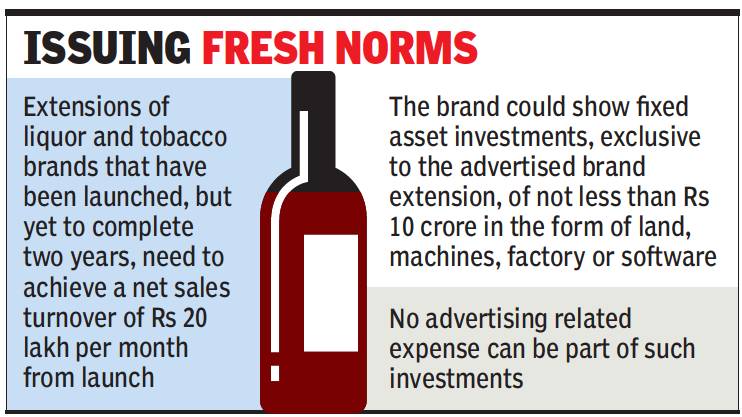
From: John Sarkar, July 16, 2021: The Times of India
The Advertising Standards Council of India (ASCI) has brought in more stringent rules to clamp down on surrogate advertising of tobacco and liquor, as distribution of these new brand extensions has become easier with the boom in e-commerce.
While the original provisions to govern surrogate advertising of liquor and tobacco are still in place, fresh norms have been introduced to check new launches related to these products, Manisha Kapoor, secretary-general at ASCI told TOI. “We have formulated these provisions after consultations with the government, the censor board and all other stakeholders,” said Kapoor.
Extensions of liquor and tobacco brands that have been launched, but haven’t yet completed two years, need to achieve a net sales turnover of Rs 20 lakh per month from launch. Apart from this, the brand could also show fixed asset investments, which are exclusive to the advertised brand extension, of not less than Rs 10 crore in the form of land, machines, factory or software, in case the product is being manufactured or developed by the advertiser. No advertising related expense can be part of such investments, the copy of the provisions which TOI has reviewed, said.
“The rules could have been brought in looking at the future. Earlier surrogate advertising used to entail bottled water, soda, music CDS or even an airline (Kingfisher),” said Harish Bijoor, brand expert and founder at Harish Bijoor Consults. “But currently the proliferation of business-to-consumer (B2C) brands are on the rise. And nobody is stopping a liquor or a tobacco brand to open a portal tomorrow to market branded goods (not liquor or tobacco) to consumers directly.”
The original rules for surrogate advertising remain the same such as for a brand that is present in the market for more than two years, the sales turnover of the product or service should exceed Rs 5 crore per year nationally or Rs 1 crore per annum per state where distribution has been established. And other than being registered with a government authority such as GST, FSSAI or FDA, the brand extension business needs to be audited by independent organisations such as NielsenIQ.

